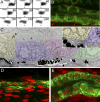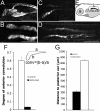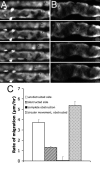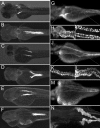Collective cell migration drives morphogenesis of the kidney nephron
- PMID: 19127979
- PMCID: PMC2613420
- DOI: 10.1371/journal.pbio.1000009
Collective cell migration drives morphogenesis of the kidney nephron
Abstract
Tissue organization in epithelial organs is achieved during development by the combined processes of cell differentiation and morphogenetic cell movements. In the kidney, the nephron is the functional organ unit. Each nephron is an epithelial tubule that is subdivided into discrete segments with specific transport functions. Little is known about how nephron segments are defined or how segments acquire their distinctive morphology and cell shape. Using live, in vivo cell imaging of the forming zebrafish pronephric nephron, we found that the migration of fully differentiated epithelial cells accounts for both the final position of nephron segment boundaries and the characteristic convolution of the proximal tubule. Pronephric cells maintain adherens junctions and polarized apical brush border membranes while they migrate collectively. Individual tubule cells exhibit basal membrane protrusions in the direction of movement and appear to establish transient, phosphorylated Focal Adhesion Kinase-positive adhesions to the basement membrane. Cell migration continued in the presence of camptothecin, indicating that cell division does not drive migration. Lengthening of the nephron was, however, accompanied by an increase in tubule cell number, specifically in the most distal, ret1-positive nephron segment. The initiation of cell migration coincided with the onset of fluid flow in the pronephros. Complete blockade of pronephric fluid flow prevented cell migration and proximal nephron convolution. Selective blockade of proximal, filtration-driven fluid flow shifted the position of tubule convolution distally and revealed a role for cilia-driven fluid flow in persistent migration of distal nephron cells. We conclude that nephron morphogenesis is driven by fluid flow-dependent, collective epithelial cell migration within the confines of the tubule basement membrane. Our results establish intimate links between nephron function, fluid flow, and morphogenesis.
Conflict of interest statement
Competing interests. The authors have declared that no competing interests exist.
Figures








References
-
- Solnica-Krezel L. Gastrulation in zebrafish – all just about adhesion. Curr Opin Genet Dev. 2006;16:433–441. - PubMed
-
- Keller R. Shaping the vertebrate body plan by polarized embryonic cell movements. Science. 2002;298:1950–1954. - PubMed
-
- Dehaan RL. Migration patterns of the precardiac mesoderm in the early chick embrvo. Exp Cell Res. 1963;29:544–560. - PubMed
-
- Lubkin SR. Branched organs: mechanics of morphogenesis by multiple mechanisms. Curr Top Dev Biol. 2008;81:249–268. - PubMed
-
- Friedl P, Hegerfeldt Y, Tusch M. Collective cell migration in morphogenesis and cancer. Int J Dev Biol. 2004;48:441–449. - PubMed
Publication types
MeSH terms
Substances
Grants and funding
LinkOut - more resources
Full Text Sources
Other Literature Sources
Molecular Biology Databases

